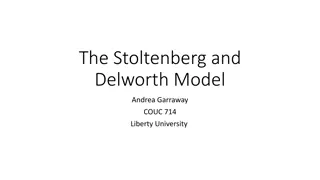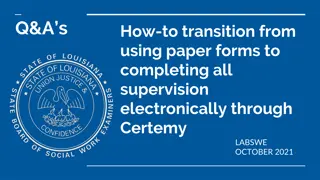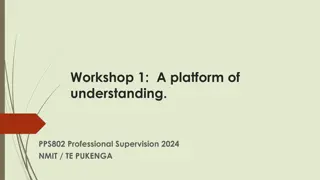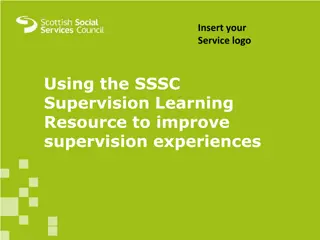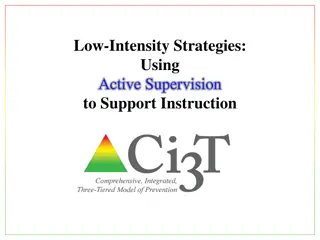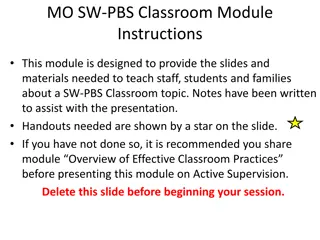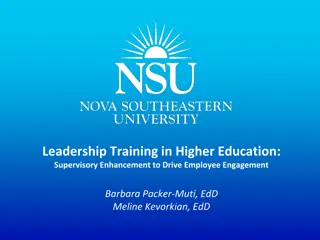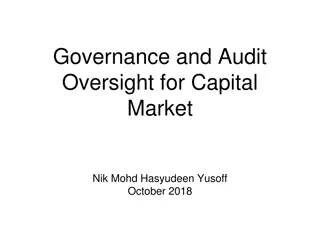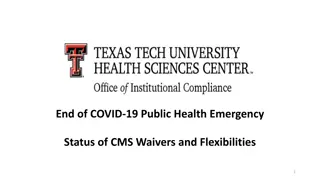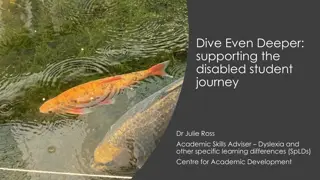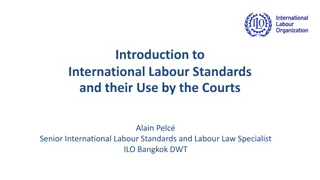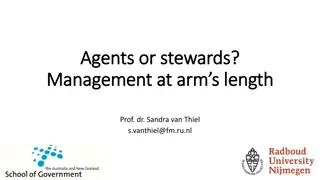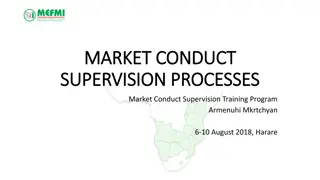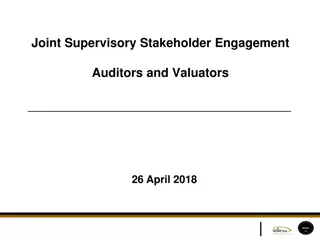Understanding Models of Postgraduate Supervision and Different Supervisory Approaches
Explore the various roles, styles, and models of postgraduate supervision, delving into the distinctions between supervisor tasks, interaction approaches, and supervision structures. Learn how different supervision models like one-on-one, panel, project, and doctoral programme supervision impact research outcomes. Delve into the characteristics of traditional and mixed supervision approaches and how they affect doctoral identity formation, community sense, and supervisory teams. Understand the influence of different types of supervisors, disciplinary pedagogy, and institutional processes on the supervision process. Lastly, discover two key approaches to supervision – technical-rationality and negotiated order, and their implications for the supervisory process across various disciplines.
Download Presentation

Please find below an Image/Link to download the presentation.
The content on the website is provided AS IS for your information and personal use only. It may not be sold, licensed, or shared on other websites without obtaining consent from the author. Download presentation by click this link. If you encounter any issues during the download, it is possible that the publisher has removed the file from their server.
E N D
Presentation Transcript
Roles, models and styles How are roles, approaches/styles and models of PG supervision distinguished in the literature? Possible understandings: roles (the various tasks a supervisor must accomplish), styles or approaches (the ways in which a supervisor interacts with the student) models (the particular structure of supervision whether singular, project based, co-supervision etc) How do they affect each other?
Models of supervision One-on-one Supervisor and co-supervisor Panel supervision Project supervision Doctoral Programme/School Other?
Supervision models APPROACHES CHARACTERISTICS Traditional Isolation (Manathunga 2005) Limited numbers, distance, diversity (Wisker et al. 2007) Atlas complex and power (Pearson & Kayrooz 2004) Coaching and mentor roles (Gardner 2008; Kamler 2008) Interaction relates to quality (Lovitts 2008) Sense of community (Malfroy 2005) Enculturation and doctoral identity formation (Samara 2006) Distributed power (Guilfoyle 2006) Experience mix (Nulty et al. 2009) Flexibility (Croussard 2008) Delegation and acquiring supervisory skills (Lee 2009) Distributed management challenges (Bitzer & Albertyn 2011) Variation in supervisory roles and responsibilities (Wisker et al. 2009) Developing supervisor planning frameworks (Bitzer & Albertyn 2011) Candidate groups (Cohort model?) Supervisory teams/ panels Mixed approach
Different kinds of supervisor different kinds of supervision Supervisor / co- supervisor Disciplinary pedagogy Departmental practices PhD/ Masters Institutional processes How does each of the following affect supervision? Funders requirements Full time/ P/T
Two kinds of approach to supervision (Wisker 2005) Technical- rationality -emphasizes technique Negotiated order -emphasizes changes in process
Typology of Disciplines (Muller, 2008: 12) Abstract, strong classification Practical, real world Biglan (1973) Hard pure Soft pure Hard applied Soft applied Kolb (1981) Abstract reflective Concrete Reflective possible problems and methodologies Abstract active Concrete active Agreement on problem identification and methodology Range of Examples Natural sciences Social sciences Science- based professions Social professions
Cultural Style of Tribes (Muller 2008: 12) Hard pure Hard applied Soft pure Soft applied Competitive, gregarious, politically well- organised, task oriented, high publication rate Entrepreneurial, cosmopolitan, role oriented, patents rather than publications, contract work Individualistic, loosely organised, person oriented, low publication rate, funding less important Status anxiety, prey to intellectual fashions, power oriented, low publication rate, vulnerable to funding pressures
Cognitive style of Tribes (Muller 2008:13) Hard pure Hard applied Soft pure Soft applied Cumulative, iterative; Atomistic; Pursuit of universals; Quantities and simplification; Discovery/ explanation. Purposive; Pragmatic; Know-how via hard knowledge; Mastery of environment; Products/ techniques. Reiterative; Holistic; Pursuit of particulars; Qualities and complication; Understanding/ interpretation. Functional; Utilitarian; Know-how via soft knowledge; Enhancement of practice; Protocols/ procedures.
Implications for supervision (Muller 2008, Boughey 2010) Because the hards enjoy more social connectedness, teaching tends to be more collaborative and what is taught tends not to be contentious. As a result, hards have more time to devote to research. Research and supervision in hard disciplines tends to be highly integrated. This means that less time is spent on supervision (Smelby 1996, 2000) - hards spend less than a quarter of the time spent by softs on supervision. Extent of identity work a factor in supervision process (Harrison 2010)
Approaches to Supervision Approaches to Supervision Anne Lee (2008) Anne Lee (2008) Functional Enculturation Critical Thinking Emancipation Relationship Development Rational progression through tasks Gatekeeping Master to apprentice Evaluation Challenge Mentoring, supporting constructivism Supervising by experience, developing a relationship Managing conflict Emotional intelligence Supervisor s Activity Directing, project management Diagnosis of deficiencies, coaching Argument, analysis Facilitation, Reflection Supervisor s knowledge & skills Organised Obedience Role modelling, Apprentice- ship Constant inquiry, fight or flight Personal growth, reframing A good team member. Emotional intelligence Possible student reaction
What does a supervisor do? If you had to represent a supervisor in a picture, what would she look like? Think about the multiple roles of the supervisor Are these all included in your institution's policy on supervision?
Selection and Appointment of Supervisors Who chooses the supervisor? When and how are they officially appointed? What model of supervision is preferred in your department / faculty / discipline? What support is provided to supervisors?


